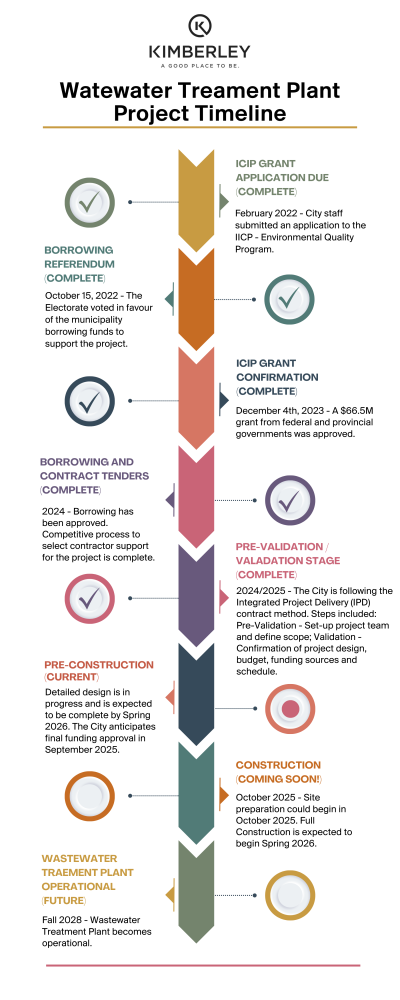
Kimberley's New Wastewater Treatment Plant
On December 4th, 2023, it was announced that the City of Kimberley would build a wastewater treatment plant (WWTP) after confirmation of combined investment commitments of more than $90.6 million from federal, provincial, and municipal governments.
This transformative infrastructure project will build a modern, resilient, and environmentally responsible WWTP. This initiative ensures compliance with BC’s Municipal Wastewater Regulation (MWR), improves effluent quality, and supports the city’s growing population and long-term sustainability goals.
On October 15th, 2025, the City held an open house where attendees reviewed important project information and spoke directly with our project team. Check out the information shared at that open house at the link below.

Key Project Changes
Since the announcement of grant funding approval, the City has been preparing to build the WWTP. During early planning, the project team reviewed the original design to update costing to ensure that it continued to align with the needs of the community. During this exercise, it was identified that the original proposed plant would result in an estimated $40 million budget overrun, primarily due to inflationary cost pressures, and that the proposed location would limit the plant's expandability to support future growth in the community.
In light of these issues, the WWTP project underwent significant changes following a comprehensive feasibility review. Initially, the City had proposed a Food Chain Reactor (FCR) system on a compact site near Marysville Falls, designed to integrate aesthetically with nearby residential areas. However, this concept proved impractical due to several constraints:
- The original site offered limited space, making future expansion difficult, and posed construction challenges due to its steep terrain and proximity to sensitive areas.
- The FCR design, while innovative, became financially unviable as post-pandemic inflation drove construction costs up by approximately $40 million—far exceeding the City’s budget.
In response, the project team pivoted to a more scalable and cost-effective solution: upgrading the existing Pollution Control Centre with a new Aerobic Granular Sludge (AGS) plant. This approach not only meets regulatory and operational goals but also leverages existing infrastructure, provides room for future growth, and is aligned with the City’s long-term sustainability and financial planning.
Notably, the City and project team have reduced costs by approximately $40 million, bringing the project within the original budget of $90.6 million.
Check out the City of Kimberley Wastewater Treatment Plant Project Validation Report!
Project Highlights
New Treatment Technology: Aerobic Granular Sludge (AGS)
The Aerobic Granular Sludge (AGS) process method was selected after a comprehensive evaluation of multiple technologies, including site visits to facilities using FCR, Membrane Bioreactors, and AGS systems. AGS offers:
- Compact footprint: Ideal for constrained sites.
- Cold-weather resilience: Proven performance in similar climates.
- Operational efficiency: Simplified process control and maintenance.
- Biological nutrient removal: Simultaneous treatment of biochemical oxygen demand, nitrogen, and phosphorus.
The AGS system will be supplied by AquaNereda®, featuring sequencing batch reactors that promote the formation of dense sludge granules, enhancing treatment performance.
The full City of Kimberley Wastewater Treatment Plant Validation Report explaining the complete AGS process will be available soon!
Facility Design
The Kimberley Wastewater Treatment Plant includes:
- Administration Building: Wood-framed structure for offices, lab, and operations.
- Headworks Building: Houses screening, grit removal, and influent pumping.
- AGS Process Block: Contains biological reactors, tertiary filters, and blower systems.
- UV Disinfection: Upgraded within the existing facility to meet future flow and redundancy requirements.
- Solids Management: This includes thickening via dissolved air flotation, dewatering with centrifuges, and odour control systems.
All new buildings are designed to post-disaster standards (except the admin building) and incorporate energy-efficient HVAC and lighting systems.
Location
The facility will be built near the existing Pollution Control Centre. This location was chosen for its:
- Reduced environmental and archaeological impact
- Improved constructability and access
- Flood resilience: Building elevations exceed the 10,000-year flood level
- Geotechnical stability: Site investigations confirmed suitable soil and groundwater conditions
Budget and Grant Funds
The original design for Kimberley’s Wastewater Treatment Plant had escalated to an estimated $140 million, making the project financially unfeasible. In response, the City and project team identified a more efficient and appropriately scaled treatment process that better suits the community’s needs. This redesign has reduced the total project cost to $90.5 million, aligning within the previously approved grant and borrowing proceeds—a significant achievement in cost management and project viability.
To help manage complexity and reduce financial risk, the project is being delivered through an Integrated Project Delivery (IPD) model. This collaborative approach brings together the City, designers, and builders under a shared contract structure that promotes transparency, cost certainty, and joint accountability. IPD helps ensure that decisions are made collectively and proactively, minimizing unexpected costs and delays while maximizing value for the community.
The City of Kimberley is also working closely with the Governments of British Columbia and Canada, including the Ministry of Environment and Parks and the Ministry of Housing and Municipal Affairs, to confirm the continued eligibility and use of approved grant funding for the redesigned facility. These efforts ensure the revised project scope remains aligned with funding requirements and regulatory expectations.
WWTP Funding Breakdown
Total Approved Project Budget: $90,638,716
Funding Sources:
- ICIP Grant: $66,465,370
- Borrowing Proceeds: $23,225,000
- Land Development Reserve: $948,346
Total Funding $90,638,716
Indigenous Consultation
The City of Kimberley has prioritized meaningful consultation with Indigenous communities throughout the planning and development of the WWTP. Recognizing that the facility is located on the unceded traditional territory of the Ktunaxa Nation and the Shuswap Band, the City has worked collaboratively with these communities to ensure the project reflects shared values of environmental stewardship, cultural respect, and commitment to reconciliation. This engagement has included participation in regulatory consultations, and environmental permitting processes, where Indigenous perspectives have helped shape the design and operational goals of the facility.
Letters of support, received from ʔaq̓am and the Shuswap Band, affirm the importance of this partnership. The City has also involved Indigenous representatives in preliminary application meetings with the Ministry of Environment and Parks, ensuring their concerns are addressed proactively. The project team continues to maintain open, respectful, and culturally informed dialogue and is committed to integrating feedback into the facility’s design and long-term operations. This collaboration is not only a regulatory requirement but a foundational principle of the project, aimed at building trust and fostering lasting relationships with Indigenous communities.
Odour & Noise Control
The upgraded Kimberley Wastewater Treatment Plant has been carefully designed to reduce odour and noise impacts on nearby homes and the surrounding environment. High-odour activities—like screening, grit removal, and sludge processing—will occur in fully enclosed areas, with air captured and treated before release. This helps prevent unpleasant smells from reaching the community.
To reduce noise, equipment will be housed in insulated buildings, and the site layout has been planned to direct sound away from residential areas. Operations will also be scheduled to avoid noisy activities during sensitive times. These thoughtful design choices reflect the City’s commitment to protecting residents’ quality of life while delivering essential infrastructure.
Archaeological Assessment
To ensure cultural and historical sensitivity, the City of Kimberley engaged Pathways Archaeological Cooperative to assess the proposed site for the new Wastewater Treatment Plant. Their investigation confirmed that no registered archaeological sites exist within the project footprint, and the area has been significantly altered by past development. A Heritage Inspection Permit (HIP) has been applied for to allow further assessment if needed and to manage any potential discoveries during construction. All staff will follow a Chance Find Procedure to ensure any unexpected findings are handled respectfully and in accordance with provincial regulations and Indigenous consultation protocols.
Environment and Sustainability Measures
The upgraded Kimberley Wastewater Treatment Plant is a major step forward in protecting the local environment. The new facility will dramatically improve effluent quality, helping to safeguard the St. Mary River and downstream ecosystems. In addition to meeting modern regulatory standards, the plant has been designed with sustainability in mind—from using energy-efficient lighting and HVAC to minimizing construction emissions and waste. These efforts reflect the City’s commitment to responsible infrastructure and long-term environmental stewardship.
Project Images
Stay Informed
Stay tuned to this page for updates, community engagement opportunities, and project milestones.
Have questions? Head over to www.EngageKimberley.ca to review previously asked questions and submit your own.
We are hosting a Public Open House at Centennial Hall on October 15th, 2025. There, residents can meet the project team, view updated designs, and learn more about the future of wastewater treatment in Kimberley. Stay tuned for more details coming soon.
Page updated August 2025